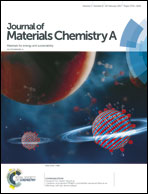The role of pre-defined microporosity in catalytic site formation for the oxygen reduction reaction in iron- and nitrogen-doped carbon materials†
Abstract
The microporous structure of Fe–N-doped carbon (Fe–N–C) catalysts plays a pivotal role in the oxygen reduction reaction (ORR) because the catalytically active N-coordinated Fe ion sites are located within accessible micropores (<2 nm). However, the distinct role of carbon support microporosity in the formation of catalytic sites in Fe–N–C catalysts remains unclear. Here, we report the effect of the pre-defined microporosity of the parent carbon support on the catalytic site density resulting from Fe–N–C catalyst synthesis, and its ultimate effect on ORR activity. The porosity, pore size distribution, and specific surface area of the carbon supports are initially controlled by using hot CO2 treatment. Then, Fe and N are doped into these supports by precursor impregnation and subsequent pyrolysis. In the synthesized Fe–N–C catalysts, the more developed microporosity in the parent carbon supports facilitates more iron and nitrogen contents, especially pyridinic nitrogen, and Fe–N–Cs derived from carbon supports with higher microporosities show enhanced ORR activity, strongly suggesting that a high catalytic site density can be achieved by utilizing carbon supports with well-developed microporosities. The most active Fe–N–C catalyst prepared using our synthetic route exhibits ORR activity comparable to that of a commercial Pt-based catalyst in alkaline media.



 Please wait while we load your content...
Please wait while we load your content...